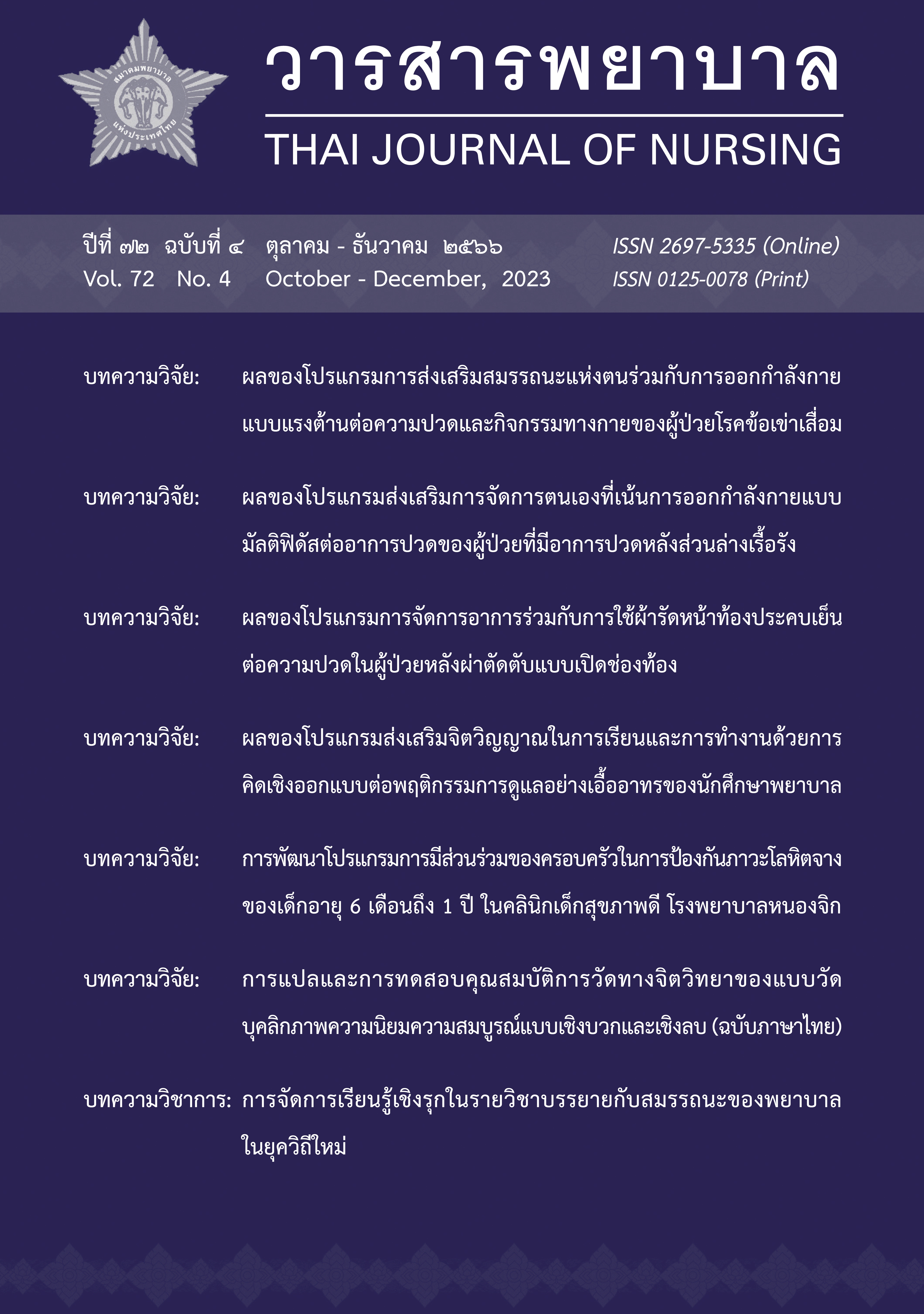Effects of self-efficacy promoting program combined with resistance exercise on pain and physical activity among patients with knee osteoarthritis
Main Article Content
Abstract
This quasi-experimental research aimed to study the effects of self-efficacy promoting program combined with resistance exercise on pain and physical activity among patients with knee osteoarthritis. Sixty patients with knee osteoarthritis, receiving care at the Orthopedics department, Thammasat University Hospital, were purposively selected and equally divided into a control group and an experimental group. Participants from both groups had similar characteristics in terms of Body Mass Index and severity of knee osteoarthritis. The experimental group received the self-efficacy promoting program combined with resistance exercise (n = 30) while the control group received usual nursing care (n = 30). The instruments consisted of the Numeric Rating Scale and the International Physical Activity Questionnaire (IPAQ-L). All instruments were examined for content validity by experts, and the reliability coefficients were 0.76 and 0.98 respectively. Data were analyzed using descriptive statistics and t-tests. The research findings were that 1) the experimental group had a lower mean score of pain than the control group, and the mean score of physical activity of the experimental group was greater than the control group (p < .05). 2) The experimental group had a lower mean score of pain than the usual nursing care, and the mean score of physical activity of the experimental group was greater than the usual nursing care. (p < .05).
Article Details

This work is licensed under a Creative Commons Attribution-NonCommercial-NoDerivatives 4.0 International License.
References
กัญชิตา เสริมสินสิริ, สุรีรัตน์ เสมศรี, และศิรัสภรณ์ นนท์อัครวาทิน. (2562). ผลของโปรแกรมการออกกำลังกายแบบก้าวตามตารางต่อการทรงตัวของผู้สูงอายุที่มีความสี่ยงต่อการหกล้ม. วารสารพยาบาลทหารบก, 20(1), 359-370.
นฤมล ลำเจริญ, ชื่นจิตร โพธิศัพท์สุข, และมุกดา หนุ่ยศรี. (2561). ผลของโปรแกรมการดูแลตนเองเพื่อลดอาการปวดข้อเข่าของผู้สูงอายุที่มีภาวะข้อเข่าเสื่อม ตำบลไชยสถาน อำเภอเมืองน่าน จังหวัดน่าน. วารสารการพยาบาลและการดูแลสุขภาพ, 36(3), 107-116.
ไพรัตน์ ศุกระศร และ ศิริพันธุ์ สาสัตย์. (2565). ผลการให้ข้อมูลผ่านไลน์ต่อความวิตกกังวลหลังผ่าตัดทำทวารเทียมในผู้สูงอายุโรคมะเร็งลำไส้ใหญ่และทวารหนัก. วารสารพยาบาลศาสตร์ จุฬาลงกรณ์มหาวิทยาลัย, 34(2), 21-34.
สิรภพ โตเสม, ธีรนุช ห้านิรัติศัย, ธงชัย สุนทรา, และบวรลักษณ์ ทองทวี. (2563). ผลของโปรแกรมการส่งเสริมกิจกรรมทางกายต่อการรับรู้สมรรถนะแห่งตนในการปฏิบัติกิจกรรมทางกายความรุนแรงของอาการข้อเข่าเสื่อม และการทรงตัวในผู้ที่มีข้อเข่าเสื่อม. รามาธิบดีพยาบาลสาร, 26(2), 172-187.
สำนักงานพัฒนานโยบายสุขภาพระหว่างประเทศ. (2566). การสูญเสียปีสุขภาวะ รายงายภาระโรคและการบาดเจ็บของประชากรไทยใน พ.ศ. 2562. แฮนดี เพรส.
Bandura, A. (1997). Self-efficacy: The exercise of control. W.H. Freeman.
Bitar, S., Omorou, A. Y., Van Hoye, A., Guillemin, F., & Rat, A. C. (2020). Five-year evolution patterns of physical activity and sedentary behavior in patients with lower-limb osteoarthritis and their sociodemographic and clinical correlates. The Journal of Rheumatology, 47(12), 1807-1814. https://doi.org/10.3899/jrheum.190854
Chang, T. F., Liou, T. H., Chen, C. H., Huang, Y. C., & Chang, K. H. (2012). Effects of elastic-band exercise on lower-extremity function among female patients with osteoarthritis of the knee. Disability and Rehabilitation, 34(20), 1727-1735.
https:// doi.org/10.3109/09638288.2012.660598
Charoencholvanich, K., & Pongcharoen, B. (2005). Oxford knee score and SF-36: Translation & reliability for use with total knee arthroscopy patients in Thailand. Journal of the Medical Association of Thailand, 88(9), 1194-1202.
Degerstedt, A., Alinaghizadeh, H., Thorstensson, C. A., & Olsson, C. B. (2020). High self-efficacy - a predictor of reduced pain and higher levels of physical activity among patients with osteoarthritis: An observational study. BMC Musculoskeletal Disorders, 21(1), 380.
https://doi.org/10.1186/s12891-020-03407-x
Gay, C., Guiguet-Auclair, C., Mourgues, C., Gerbaud, L., & Coudeyre, E. (2019). Physical activity level and association with behavioral factors in knee osteoarthritis. Annals of Physical and Rehabilitation Medicine, 62(1), 14-20. https://doi.org/10.1016/j.rehab.2018.09.005
Hanrungcharotorn, U., Pinyopasakul, W., Pongthavornkamol, K., Dajpratham, P., & Beeber, A. S. (2017). Factors influencing physical activity among women with osteoarthritis of the knee. Pacific Rim International Journal of Nursing Research, 21(1), 5-17.
Leethong-in, M. (2009). A causal model of physical activity in healthy older Thai people [Doctoral dissertation, Chulalongkorn University].Chulalongkorn University Intellectual Repository
(CUIR). https://cuir.car.chula.ac.th/bitstream/123456789/17413/1/mayuree_le.pdf
Liu, C. J., & Latham, N. K. (2009). Progressive resistance strength training for improving physical function in older adults. Cochrane Database of Systematic Reviews, (3), CD002759. https://doi.org/10.1002/ 14651858.CD002759.pub2
Marks, R. (2012). Self-efficacy and its application in the treatment of knee osteoarthritis: A critical review. Rheumatology Reports, 4(1), 34-45. https://doi.org/10.4081/rr.2012.e10
Mortensen, L., Schultz, J., Elsner, A., Jakobsen, S. S., Soballe, K., Jacobsen, J. S., Kierkegaard, S., Dalgas, U., & Mechlenburg, I. (2018). Progressive resistance training in patients with hip dysplasia: a feasibility study. Journal of Rehabilitation Medicine, 50(8), 751-758.
https://doi.org/10.2340/16501977-2371
Morsley, K., Berntzen, B., Erwood, L., Bellerby, T., & Williamson, L. (2018). Progressive resistance training (PRT) improves rheumatoid arthritis outcomes: A district general hospital (DGH) model. Musculoskeletal Care, 16(1), 13-17. https://doi.org/10.1002/msc.1193
O’Neill, T. W., & Felson, D. T. (2018). Mechanisms of osteoarthritis (OA) pain. Current Osteoporosis Reports, 16(5), 611-616. https://doi.org/10.1007/s11914-018-0477-1
Song, J., Chang, A. H., Chang, R. W., Lee, J., Pinto, D., Hawker, G., Nevitt, M., & Dunlop, D. D. (2018). Relationship of knee pain to time in moderate and light physical activities: Data from initiative. Seminars in Arthritis and Rheumatism, 47(5), 683-688.
Wallis, J. A., Taylor, N. F., Bunzli, S., & Shields, N. (2019). Experience of living with knee osteoarthritis: A systematic review of qualitative studies. BMJ Open, 9(9), Article e030060.
https://doi.org/10.1136/bmjopen-2019-030060
World Health Organization. (2022). Musculoskeletal health. https://www.who.int/news-room/factsheets/detail/ musculoskeletal-conditions


